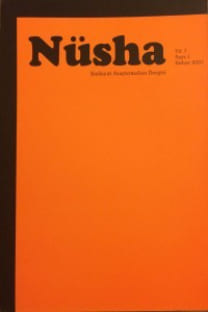MİSYON İNANCININ SANATSAL NESNELLİK VE EDEBİ ÖYKÜNME BAŞARISIZLIĞINDAKİ ROLÜNÜN HÂFIZ GAZELLERİ ÜZERİNDEN ANALİZ VE DEĞERLENDİRİLMESİ
Sanat, ayırt edici ve olağanüstü bir performans sürecidir. Sanatın bu imtiyaz ve üstünlüğü; muhataplar tarafından beğenilmesine, kalıcı olmasına ve sonuç olarak sanat eserinin başarılı olmasını olanak sağlar. Bu tür ayrıcalıklar aynı zamanda, taklit türünün oluşmasına zemin hazırlayan diğer sanatçıların taklit etmelerinin de önünü açar. Ancak, taklit tarihinin deneyimi, taklidin çoğu zaman olağanüstü ve başarılı sanat eserlerinin yaratılmasına yol açmadığını göstermektedir. Bu hakikat, söyleneni ve söylenmeyenleri farklı ifade edilme sanatı olan edebiyat alanında da kanıtlanmıştır. Hâfız'ın Divanı gibi edebiyatın zirvesi olarak kabul edilen edebi şaheserler, yazarların öykündüğü ki- genellikle bu yolda başarısız oldukları- eserler olmuştur. Bu çalışma, Hâfız Gazelleri gibi bir eserin üstünlük ve eşsizliğinin sırlarını doğrudan ve dolaylı olarak sıralayan tüm araştırmaların tarihini ele alırken, aynı zamanda Hâfız'ın (görünüşte dile getirilmeyen) dil ve zihninin sanatsal nesnelliğini ve taklitçilerinin yetersiz kalmalarının önemli nedenlerini vurgulanmaktadır. Ayrıca çalışmada, hem sanat eserinin var edilişinde hem de taklit çalışmalarında misyon-inanç unsurunun varlığı/yokluğu; endişe, sorgulama, değişebilirlik, meydan okuma, azim, dünya görüşü ve kültür oluşturma gibi bileşenler tanımlanarak betimsel-analitik yöntemle açıklanmaya çalışılmıştır.
Anahtar Kelimeler:
Hâfız, Misyon İnancı, Sanatsal Objektiflik, Edebi Öykünme
Critique and Analysis of the Role of Belief in Mission in the Artistic Objectivity and Failure of Literary Imitation with an Emphasis on Ḥāfeẓ's Ghazals
Art is a distinctive and outstanding performance process. This difference and prominence make the audience welcome and ensure its durability and consequently, the success of the work of art. Such privileges pave the way for the imitation of other artists, through which the category of imitation is formed. However, the experience of the history of imitation shows that imitation often does not lead to the creation of outstanding and successful works. This fact has also been proven in the field of literature, which is the art of expressing what is said and what is not said. The pinnacle of literary art is embodied in literary masterpieces such as Ḥāfeẓ's Divan, which has always been a model for the often failed copying of other belletrists. The present study pays attention to the history of all researches that directly and indirectly enumerate the secrets of superiority and uniqueness of a work such as Ḥāfeẓ's lyric poems and also emphasizes that (seemingly unspoken) one of the crucial reasons for the artistic objectivity of mind and language of Ḥāfeẓ and the inability of his imitators was the existence and the absence of mission-belief element in the work of both production and imitation, which is explained by the descriptive-analytical method through describing the components of heterogeneity, concern, questioning, variability, challenge-seeking, persistence, worldview development and culture-building.
Keywords:
Ḥāfeẓ, Missionary orientation, Artistic Objectivity, Literary Imitation,
___
- Âşûrî, Dâryûş (1379) İrfân ve Rindî der Şiir-i Hâfız, Çap-i nuhust, Tahran, Neşr-i Merkez.
- Enûşe, Hasan (1376) Ferheng-nâme-i Edeb,i Fârsî, Cild-i dovvum, Çap-i nuhust, Tahran, Vezâret-i Ferheng ve İrşâd-i İslâmî.
- Browne, Edward (1339) Târîh-i Edebiyât-i Îrân, Ter: Ali-Asker Hikmet, Cild-i Sevvum, Tahran, İbn-i Sinâ
- Priestley, John Boynton (1392) Seyr-i der Edebiyât-i Garb, Ter: İbrahim Yûnisî, Çap-i Heftum, Tahran, İNeşr-i Emîr Kebîr.
- Hâfız-ı Şirâzî, Hâce Şemseddin Muhammed (1387) Dîvân-ı Gazeliyyât, Be kûşiş-i Muhammed Kazvînî ve Kāsım Ganî, Çap- Sevvum, Tahran, Neşr-i Ruzene.
- Ḥazîn-i Lâhîcî, Muhammed Alî (1378). Dîvân-i eş'ar, Haz: Bîjen-i Terakkî, Tahran: Neşr-i Sâye.
- Sâdî-i Şirâzî, Muslihiddin (1374) Külliyât, Haz: Gulâm- Hüseynî Yûsufî, Çap-i Çaharum, Tahran, İntişârât-i Hârezmî.
- Şuʻâr, Caʻfer (1357) Hüner der Suhen-i Sâdî, Mecelle-i Yeğma, Şumara-i 32
- Şemisa, Sîrüs (1375) Sebk-Şinasi-yi Nezm, Çap-i Çaharum, Tahran, Neşr-i Peyâmı Nur.
- Ganî, Kâsım (1393) Târîh-i Àsr-i Hâfız, Cild- Nuhust, Tahran, Neşr-i Zevvâr.
- Firdevsî, Ebü'l-Kāsım (1382) Şahnâme, Haz: Celâl Hâlikî Mutlak,Tahran, Merkez-i Dâiretü'l-Maârif-i İslâm
- Ferzâm, Celil (1396) Hüner, İktibas, Taklit, Çap-i Evvel, Tahran, Neşr-i Nigâr. Mûsevî Bocnûrdî, Muhammed Kazım (1387) Dânişnâme-i İran, Tahran, Merkez-i Dâiretü'l-Maârif-i Buzurg-i İslâm. Meybûdî, Ahmed ibn Muhammed (1393) Keşfü'l-esrâr ve ʿuddetü'l-ebrâr, Be kûşiş-i Ali-Asker Hikmet, Tahran, Emir Kebir Naval, Reymond (1396) Hüner-i Müte'ahhid, Ter: Mani Burhani, Çap Nuhust, Tahran, Neşr-i Perend.
- ISSN: 1303-0752
- Yayın Aralığı: Yılda 2 Sayı
- Başlangıç: 2001
- Yayıncı: Oku A.Ş.
Sayıdaki Diğer Makaleler
KAYNAKLIK ETMESİ AÇISINDAN CAHİLİYE ŞİİRİNDE KADININ KONUMU
MEVLANA’DA ARAP DİLİ VE EDEBİYATININ İZLERİ
KAYSER EMÎNPÛR’UN “ÖNCELERİ/پیش از این ها” ŞİİRİNDE ÇOCUK VE ALLAH
SARAYBOSNA'NIN ŞEHDÎ OSMÂN EFENDI KÜTÜPHANESI: ARAPÇA İLIMLERINE AIT YAZMALAR
REŞAT NURİ GÜNTEKİN’ İN YAPRAK DÖKÜMÜ VE İSMÂİL FASÎH’ İN DİL-İ KÛR ROMANININ KARŞILAŞTIRMASI
LEBÎD B. RABÎA VE DİVANINDAKİ DİNÎ ŞİİR ÖRNEKLERİ
Kur'ân-ı Kerîm'de Yer Alan Kural Dışı "İsm-i Fâil" Yapılarının Anlama Yönelik Kipleri
